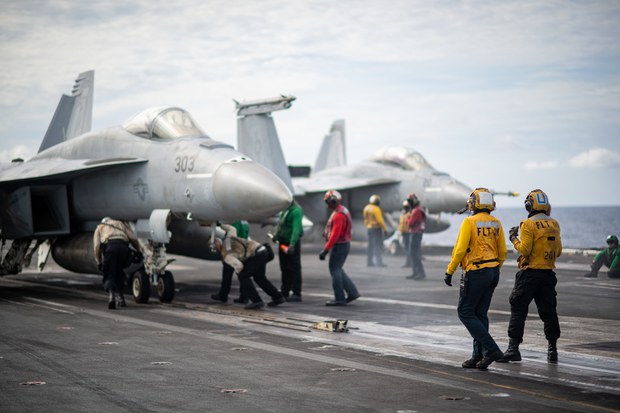China’s coast guard ‘monitors’ Philippine navy ship in disputed territory
Share

U.S. Navy aircraft carrier USS Nimitz (CVN-68) conducts flight operations in the South China Sea on Jan. 31., 2023.
The Chinese coast guard and maritime militia appear to have tailed a Philippine naval vessel inside the Philippines’ exclusive economic zone, a U.S. expert said, as U.S. Defense Secretary Lloyd Austin visits the country to push for better access to local military bases.
At least two China Coast Guard (CCG) and a number of Chinese maritime militia ships were monitoring and tailing the movements of the patrol vessel BRP Andres Bonifacio (PS-17) of the Philippine Navy on Wednesday, said Ray Powell, Project Myoushu (South China Sea) lead at Stanford University in California.
As of 1 p.m. Manila time, two Chinese maritime militia vessels departed Mischief Reef in the Spratly Islands, seemingly “on an intercept course” with the Bonifacio as it circumnavigated Reed (Recto) Bank, said Powell.
The monitoring continued as the Philippine ship conducted a search operation in the waters within the country’s exclusive economic zone (EEZ).
An EEZ gives a state exclusive access to the natural resources in the waters and seabed but those in the South China Sea overlap with the so-called nine-dash line that China uses to claim “historical rights” to most of the sea.
“One of the maritime militia ships passed by going north and the CCG ship didn’t seem to interfere in the search operation,” Powell told RFA.
He added that another militia ship “seemed to turn around once it realized the Philippine ship wasn’t going to approach the Second Thomas Shoal,” administered by Manila but claimed by both countries.
Although they didn’t seem to directly interfere with the Bonifacio’s movements, “the timing here is very suggestive that they planned these movements to coincide with the Philippines’ operation,” the retired U.S. Air Force colonel turned academic said.
Robust coast guard presence
In early December 2022, the Chinese coast guard was accused of stopping the same ship from approaching Scarborough Shoal, known in the Philippines as Panatag Shoal, which is only 198 kilometers (123 miles) from the strategic Subic Bay but under China’s control.
A U.N. tribunal in 2016 dismissed China’s sweeping claims over most of the South China Sea, including Scarborough Shoal, but Beijing refused to recognize the ruling.
Manila said in recent months CCG ships have stepped up their activities and harassment against Philippine law enforcement vessels in the Philippines EEZ.
In November 2022, CCG ship 5203 intercepted a Philippine Navy ship which was towing some wreckage from a Chinese Long March rocket and seized the wreckage.
In December 2022 CCG vessel 5205 attempted to obstruct a Philippine naval ship that was carrying supplies for troops stationed on the grounded BRP Sierra Madre at the Second Thomas Shoal.
A new study by the Asia Maritime Transparency Initiative (AMTI), a research institution at the Center for Strategic and International Studies in Washington D.C., asserted that “China’s coast guard presence in the South China Sea is more robust than ever.”
The report said CCG ships “maintained near-daily patrols at key features” in the sea, despite that most of them are located in neighboring countries’ EEZs.
CCG patrol ships 5203, 5204 and 5205 seem to have a semi-permanent presence here, data obtained via ship tracking website MarineTraffic show.
U.S. access to bases
Meanwhile, the U.S. aircraft carrier USS Nimitz and its accompanying vessels are operating nearby, the U.S. Pacific Fleet announced.
The Nimitz Carrier Strike Group is “conducting routine operations” in the South China Sea, the U.S. Navy said. The carrier has been in the South China Sea since mid-December, 2022, and paid a port visit to Singapore around the Lunar New Year before returning to near the Philippines.
Its latest location, according to the satellite imaging company Planet, is about 200 kilometers (124 miles) west of Manila.
U.S. Defense Minister Lloyd Austin is currently in the Philippines on an official visit.
The two countries announced on Thursday that Manila will give the U.S. access to four more locations under the 2014 Enhanced Defense Cooperation Agreement (EDCA), allowing the U.S. to rotate troops to a total of nine bases throughout the Philippines.
In addition, the U.S. will help the Philippines modernize its military with $82 million allocated for infrastructure improvements at five current EDCA sites, a joint announcement said.
Responding to the news, Chinese Foreign Ministry spokesperson Mao Ning said that “defense and security cooperation between countries should be conducive to regional peace and stability, and should not target third parties or harm the interests of third parties.
“Out of selfish interests, the U.S. continues to strengthen its military deployment in the region with a zero-sum mentality, endangering regional peace and stability,” she said.







